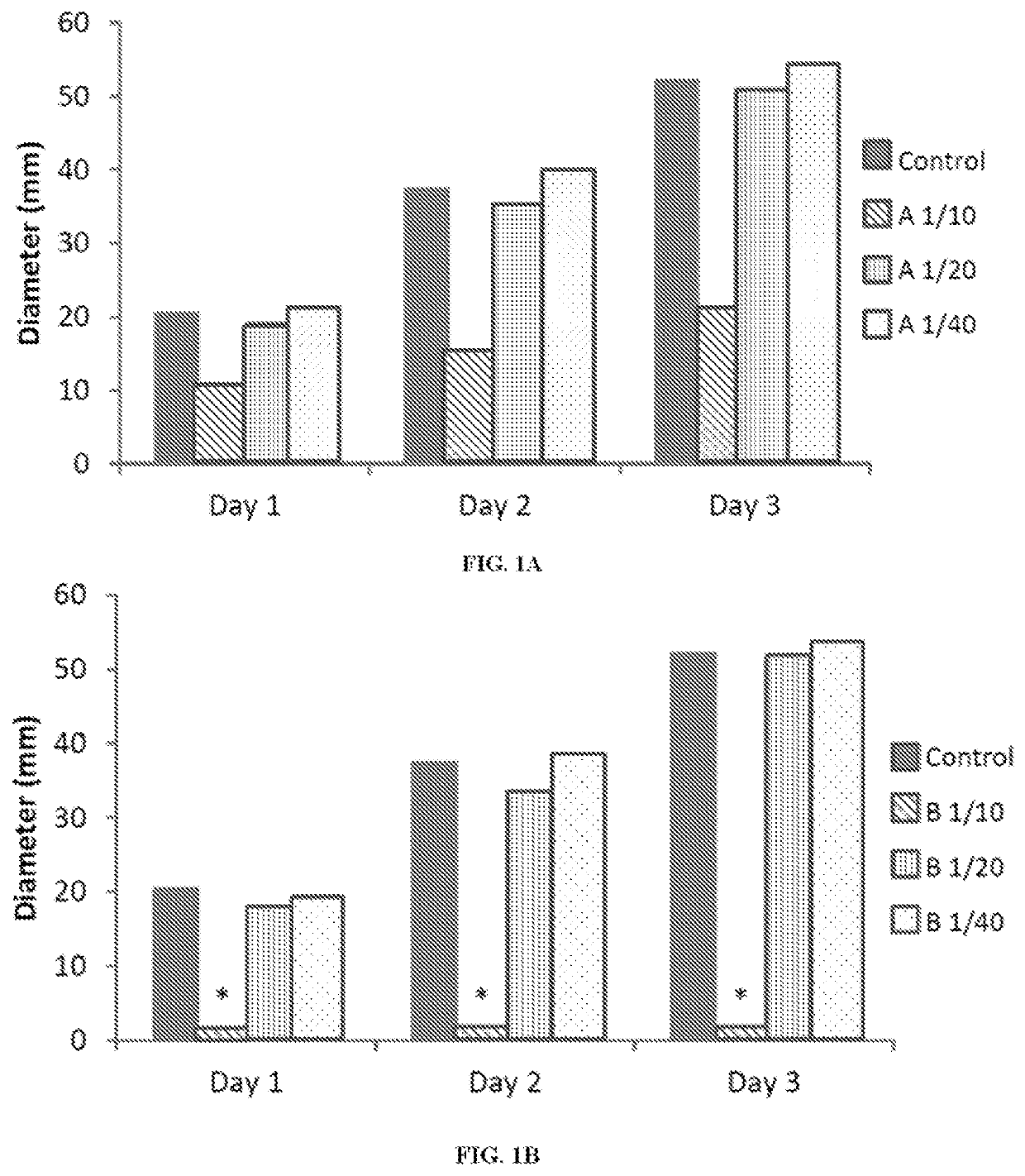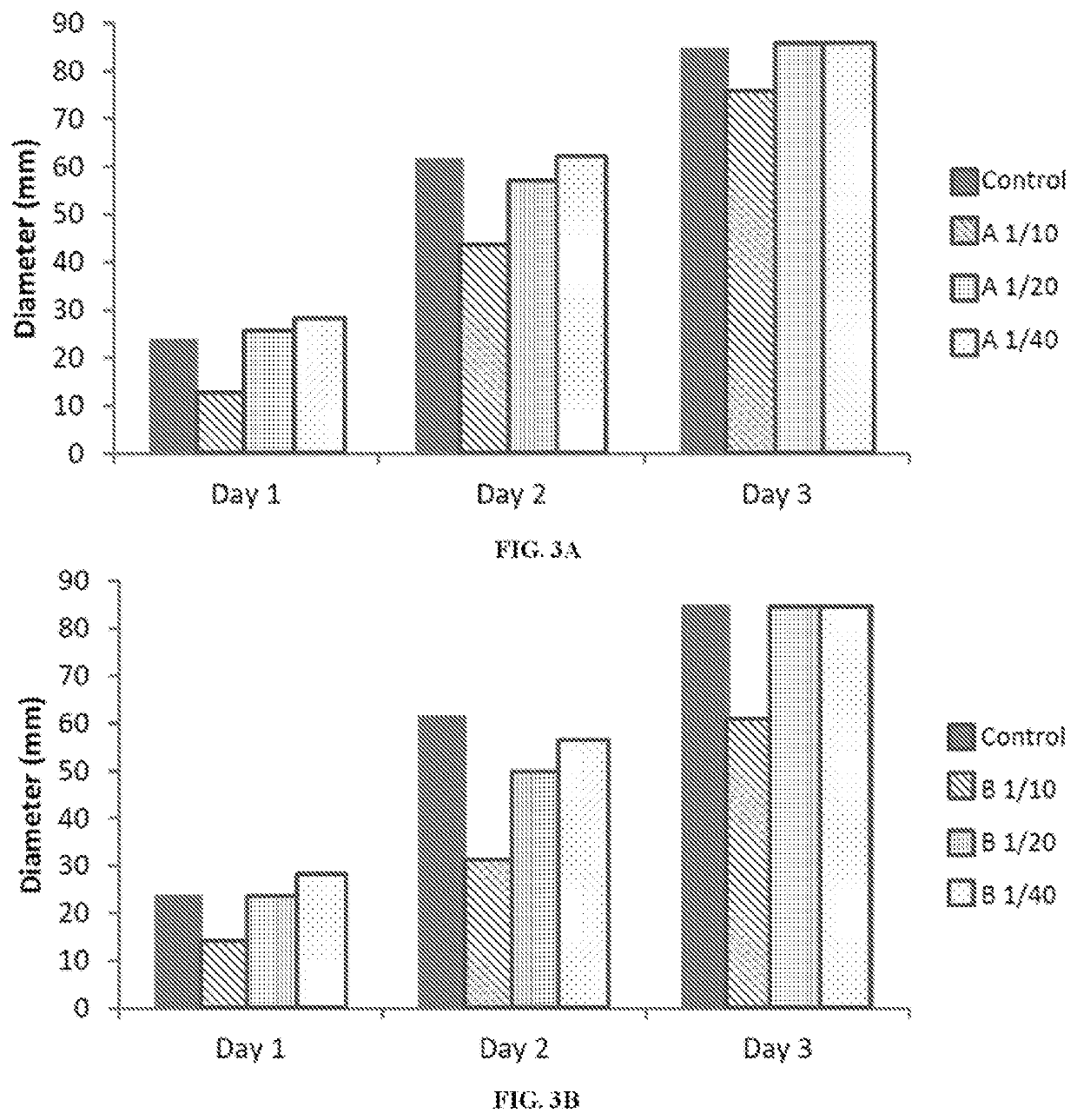Microbial compositions and methods for bioprotection
a technology of compositions and microorganisms, applied in the field of plant bioprotectant compositions, can solve problems such as negative and sometimes irreparable effects on soil health and the environmen
- Summary
- Abstract
- Description
- Claims
- Application Information
AI Technical Summary
Benefits of technology
Problems solved by technology
Method used
Image
Examples
example 1
A Method for Making a Microbial Culture for Preparation of a Cell-Free Supernatant
[0151]A microorganism, such as a bacteria or yeast, was selected for inclusion in the composition, based on its enzyme activity profile, its ability to grow in media, its lack of spore formation, or other criteria described herein. The microorganism was grown in standard medium for that organism and when at an exponential growth phase, was aliquoted and stored. The media for growing microorganisms, such as yeasts and bacteria, are known to those skilled in the art.
[0152]For example, in making I-M Lab, an aliquot (5 mL of cells at 1×106) of each of IN-LH1, IN-BS1 and L. casei (IN-LC1) were added to a media suitable for lactobacilli and bacillus, such as water (700 mL), molasses (37.5 g), bentonite clay (3.75 g), and sea salt (3.75 g). The bacteria were grown to an optical density of 0.752 determined at 600 nm (hereinafter, “OD600”).
[0153]In making I-M PNSB, an aliquot (5 mL of cells at 1×106) of IN-RPI ...
example 2
on of a Cell-Free Supernatant
[0173]Cell-free supernatant (“CFS”) composition was obtained by centrifuging the microbial culture prepared using the methods as described above for at least 10 minutes at a centrifugal force of 14,171×g. The CFS composition was then checked by absorbance (600 nm) to determine whether any microbes were still present and the liquid portion is removed via decanting or pipetting. The supernatant was then filter sterilized with a 0.22 μM micron filter (MCE membrane). The CFS can be filter sterilized using filters or other methods known to those of skill in the art.
example 3
e Compositions and Methods to Inhibit Fungal Pathogens at Different Dilutions
[0174]Tournas et al. (2005) (Crit. Rev. Microbiol. 31, 33-44) reported that bacterial spoilage of vegetables are most commonly caused by Erwinia carotovora, Pseudomonas spp., Xanthomonas campestris. The fungi causing the largest impact on the spoilage of fresh vegetables include various species of the genera Colletotrichum, Fusarium, Phytophthora, and Pythium among many others. In 1980, Kennedy and Alcorn found that over two decades the most significant microorganism causing crop loss, in decreasing order, were Xanthomonas vesicatoria, E. carotovora, Agrobacterium tumefaciens, Corynebacterium sepedonicum, X. malvacearum, E. amylovora, Pseudomonas glycinea and P. syringae (Kennedy and Alcorn (1980) Plant Disease 64, 674-676). At that time the greatest monetary loss was approximately $54,500,000 caused by P. glycinea on soybean in Iowa. Xanthomonas spp can attack at least 350 different plant diseases. Bacteri...
PUM
| Property | Measurement | Unit |
|---|---|---|
| pH | aaaaa | aaaaa |
| pH | aaaaa | aaaaa |
| pH | aaaaa | aaaaa |
Abstract
Description
Claims
Application Information
 Login to view more
Login to view more - R&D Engineer
- R&D Manager
- IP Professional
- Industry Leading Data Capabilities
- Powerful AI technology
- Patent DNA Extraction
Browse by: Latest US Patents, China's latest patents, Technical Efficacy Thesaurus, Application Domain, Technology Topic.
© 2024 PatSnap. All rights reserved.Legal|Privacy policy|Modern Slavery Act Transparency Statement|Sitemap



